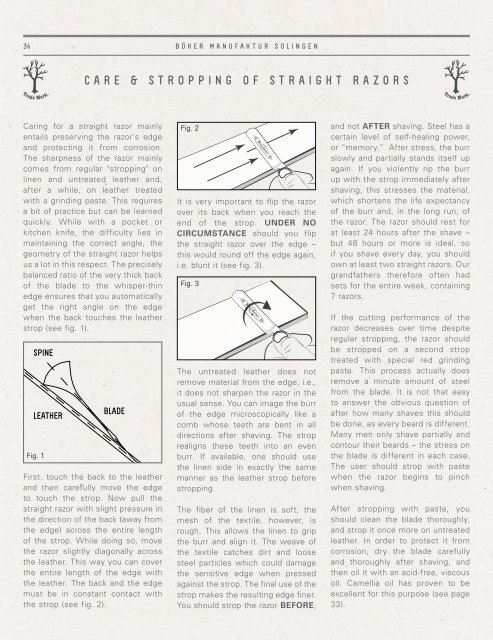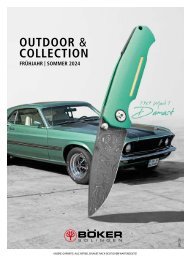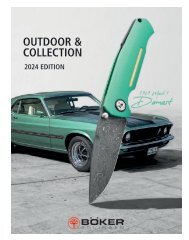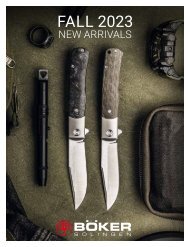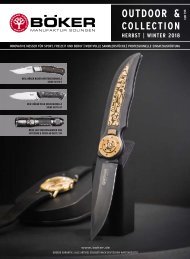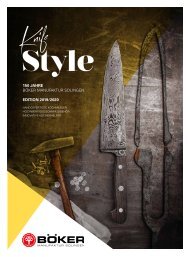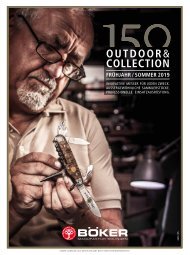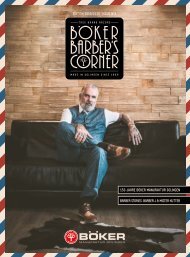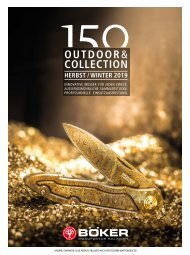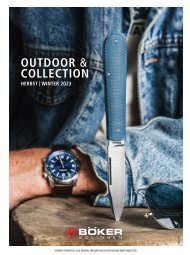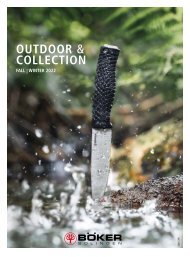2023-1_barbers_corner
Create successful ePaper yourself
Turn your PDF publications into a flip-book with our unique Google optimized e-Paper software.
34 BÖKER MANUFAKTUR SOLINGEN<br />
BÖKER MANUFAKTUR<br />
35<br />
CARE & STROPPING OF STRAIGHT RAZORS<br />
SHARPENING & ACCESSORIES<br />
Caring for a straight razor mainly<br />
entails preserving the razor's edge<br />
and protecting it from corrosion.<br />
The sharpness of the razor mainly<br />
comes from regular "stropping" on<br />
linen and untreated leather and,<br />
after a while, on leather treated<br />
with a grinding paste. This requires<br />
a bit of practice but can be learned<br />
quickly. While with a pocket or<br />
kitchen knife, the difficulty lies in<br />
maintaining the correct angle, the<br />
geometry of the straight razor helps<br />
us a lot in this respect. The precisely<br />
balanced ratio of the very thick back<br />
of the blade to the whisper-thin<br />
edge ensures that you automatically<br />
get the right angle on the edge<br />
when the back touches the leather<br />
strop (see fig. 1).<br />
SPINE<br />
LEATHER<br />
Fig. 1<br />
BLADE<br />
First, touch the back to the leather<br />
and then carefully move the edge<br />
to touch the strop. Now pull the<br />
straight razor with slight pressure in<br />
the direction of the back (away from<br />
the edge) across the entire length<br />
of the strop. While doing so, move<br />
the razor slightly diagonally across<br />
the leather. This way you can cover<br />
the entire length of the edge with<br />
the leather. The back and the edge<br />
must be in constant contact with<br />
the strop (see fig. 2).<br />
Fig. 2<br />
It is very important to flip the razor<br />
over its back when you reach the<br />
end of the strop. UNDER NO<br />
CIRCUMSTANCE should you flip<br />
the straight razor over the edge –<br />
this would round off the edge again,<br />
i.e. blunt it (see fig. 3).<br />
Fig. 3<br />
The untreated leather does not<br />
remove material from the edge, i.e.,<br />
it does not sharpen the razor in the<br />
usual sense. You can image the burr<br />
of the edge microscopically like a<br />
comb whose teeth are bent in all<br />
directions after shaving. The strop<br />
realigns these teeth into an even<br />
burr. If available, one should use<br />
the linen side in exactly the same<br />
manner as the leather strop before<br />
stropping.<br />
The fiber of the linen is soft, the<br />
mesh of the textile, however, is<br />
rough. This allows the linen to grip<br />
the burr and align it. The weave of<br />
the textile catches dirt and loose<br />
steel particles which could damage<br />
the sensitive edge when pressed<br />
against the strop. The final use of the<br />
strop makes the resulting edge finer.<br />
You should strop the razor BEFORE,<br />
and not AFTER shaving. Steel has a<br />
certain level of self-healing power,<br />
or “memory.” After stress, the burr<br />
slowly and partially stands itself up<br />
again. If you violently rip the burr<br />
up with the strop immediately after<br />
shaving, this stresses the material,<br />
which shortens the life expectancy<br />
of the burr and, in the long run, of<br />
the razor. The razor should rest for<br />
at least 24 hours after the shave –<br />
but 48 hours or more is ideal, so<br />
if you shave every day, you should<br />
own at least two straight razors. Our<br />
grandfathers therefore often had<br />
sets for the entire week, containing<br />
7 razors.<br />
If the cutting performance of the<br />
razor decreases over time despite<br />
regular stropping, the razor should<br />
be stropped on a second strop<br />
treated with special red grinding<br />
paste. This process actually does<br />
remove a minute amount of steel<br />
from the blade. It is not that easy<br />
to answer the obvious question of<br />
after how many shaves this should<br />
be done, as every beard is different.<br />
Many men only shave partially and<br />
contour their beards – the stress on<br />
the blade is different in each case.<br />
The user should strop with paste<br />
when the razor begins to pinch<br />
when shaving.<br />
After stropping with paste, you<br />
should clean the blade thoroughly,<br />
and strop it once more on untreated<br />
leather. In order to protect it from<br />
corrosion, dry the blade carefully<br />
and thoroughly after shaving, and<br />
then oil it with an acid-free, viscous<br />
oil. Camellia oil has proven to be<br />
excellent for this purpose (see page<br />
33).<br />
1 BELGIAN WHETSTONE BLUE<br />
The blue Belgian whetstone features<br />
a content of garnet of 30% and<br />
sharpens a little slower than the<br />
yellow whetstone (above). The thicker<br />
natural layers allow larger whetstone<br />
sizes. Individual shaping is possible.<br />
5000 grit. Comes in an attractive<br />
wooden box. Length: 8.00". Width:<br />
2.50". Thickness: 0.75". Weight: 23 oz.<br />
ITEM NO. 09BB001 $ 146.95<br />
2 BOKER SUPER ERASER<br />
The versatile Boker Super Eraser<br />
is perfect for grinding, scrubbing,<br />
smoothing, cleaning, and polishing<br />
metal surfaces, with its fine 240 grit.<br />
Especially with blades made of carbon<br />
steel, the typical dark spots as well<br />
as rust can appear after some time.<br />
This is absolutely normal and does not<br />
represent a defect, but it may disturb<br />
the optical appearance of the knife.<br />
To give the blades a new shine again,<br />
regular care with the Boker Super<br />
Eraser is therefore recommended.<br />
Made in Germany. Dimensions: 3.15"<br />
x 1.97" x 0.79".<br />
ITEM NO. 09BO304 $ 15.95<br />
3 BOKER CAMELLIA OIL<br />
This high quality, pure camellia oil<br />
is made according to a traditional<br />
Chinese recipe, and has many uses.<br />
The thin oil is extracted from the<br />
seed of the camellia tree, is taste<br />
neutral, odorless, and does not dry.<br />
The camellia oil is food safe and<br />
impresses with its special purity.<br />
Corrosion protection<br />
The acid-free, non-resinous, and<br />
non-evaporating camellia oil is<br />
traditionally used to protect from<br />
corrosion in the care of high quality<br />
knife blades made from carbon steel,<br />
as well as tools and weapons. It<br />
1<br />
2<br />
is purely organic and perfect for<br />
preserving non-stainless kitchen<br />
knives and straight razors as – in<br />
contrast to other care oils – does not<br />
form an emulsion with water.<br />
Wood protection<br />
The low-viscosity oil quickly absorbs<br />
into the wood and protects from<br />
moisture, dirt, and UV radiation.<br />
Camellia oil is clear, does not discolor<br />
the wood, and brings out the grain<br />
beautifully. Outstanding for the care<br />
of high quality straight razor handles<br />
and kitchen knife handles made from<br />
fine woods.<br />
ITEM NO. 04BO175 $ 24.95<br />
3


